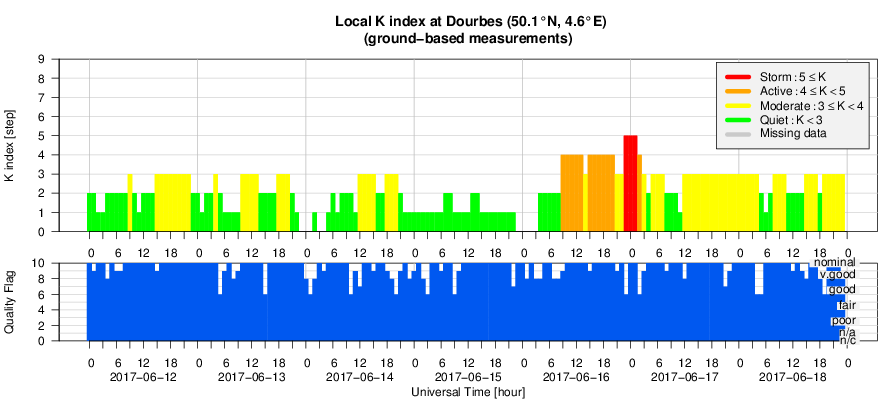- Table of Content
- 1.A day on the S...
- 2.ESWW14 - a Des...
- 3.PROBA2 Observa...
- 4.Review of sola...
- 5.The Internatio...
- 6.Review of geom...
- 7.Geomagnetic Ob...
- 8.SIDC Space Wea...
- 9.Review of iono...
- 10.Future Events
2. ESWW14 - a Design 4 a Ticket
3. PROBA2 Observations (12 Jun 2017 - 18 Jun 2017)
4. Review of solar activity
5. The International Sunspot Number
6. Review of geomagnetic activity
7. Geomagnetic Observations at Dourbes (12 Jun 2017 - 18 Jun 2017)
8. SIDC Space Weather Briefing
9. Review of ionospheric activity (12 Jun 2017 - 18 Jun 2017)
10. Future Events
A day on the Sun
Solar activity was again very low last week, with no C-class flares recorded. Only 2 active regions were observed: the stable region NOAA 2662, and a region that emerged on 14 June close to an equatorial coronal hole. That region (NOAA 2663) started to emerge shortly after the eruption of a filament on the southern hemisphere. A filament is a mass of charged particles squeezed between magnetic fields of opposite magnetic polarity.
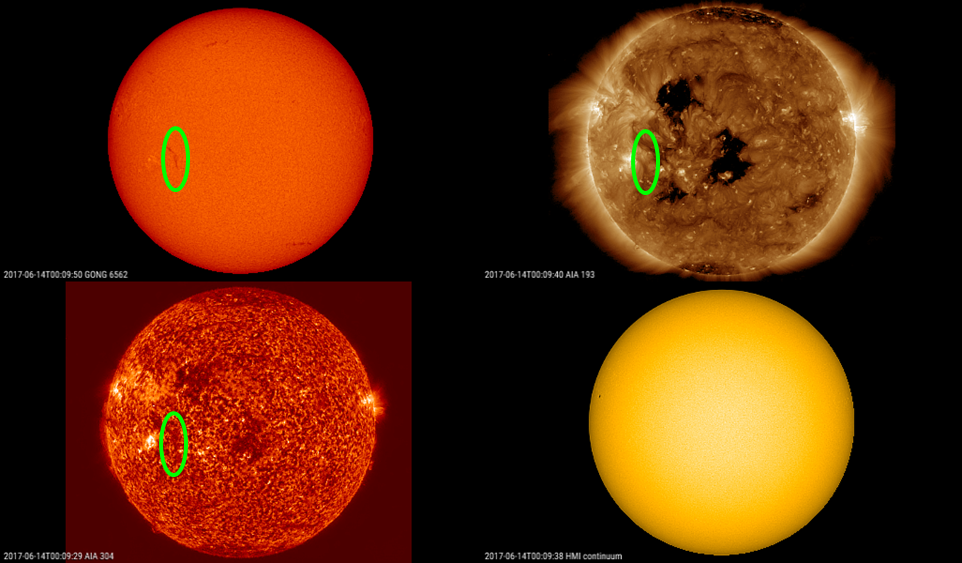
The gif-animation at http://www.stce.be/news/389/welcome.html was made with JHelioviewer (http://www.jhelioviewer.org/ ) and shows the filament eruption (indicated in green on the screenshot) and the subsequent emergence of NOAA 2663 (indicated in blue) in various wavelengths during 24 hours on 14 June. The upper-right images are made by SDO/HMI (https://sdo.gsfc.nasa.gov/ ) and show the Sun in white light (the "solar surface") at temperatures near 6.000 degrees. Tiny sunspot region NOAA 2663 shows up near the end of the clip. The upper-left images are from the GONG H-alpha network (http://halpha.nso.edu/ ) and show the Sun's lower atmosphere ("chromosphere") in the red part of the visible spectrum (H-alpha; temperatures around 10.000 degrees). Comparing the screenshots at the beginning of the day (above) and the end of the day (below) clearly shows that the filament has disappeared.
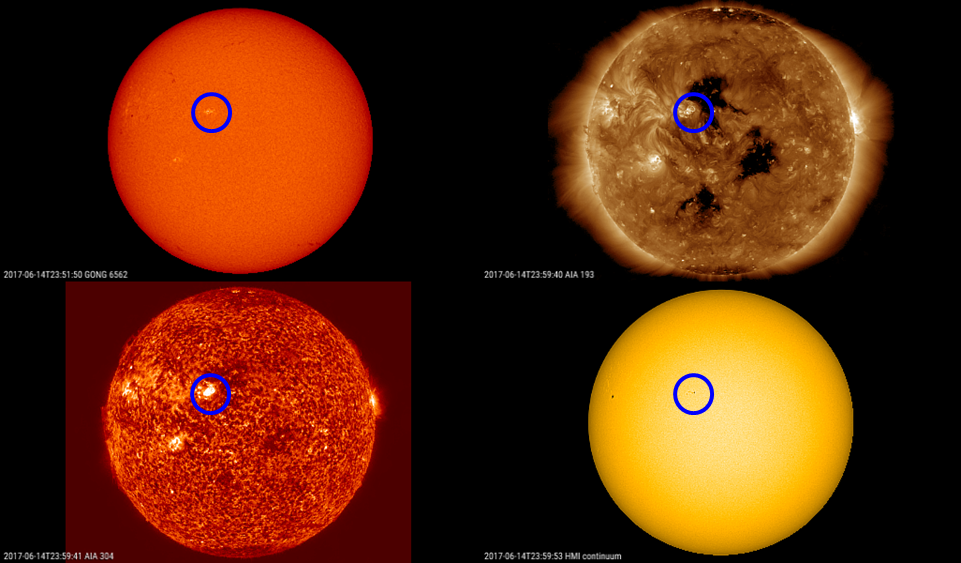
The bottom series of images show more SDO pictures of the Sun , but now in extreme ultraviolet (EUV). Bottom-left are SDO/AIA 304 images showing the evolution of the events in the Sun's transition zone at temperatures near 80.000 degrees. Bottom-right are SDO/AIA 193 images showing the Sun's hot outer atmosphere ("corona") at temperatures near 1.3 million degrees. The dark holes are relatively small coronal holes (CHs) of which the associated particle streams affected the earth-environment from 16 till 19 June, resulting in minor storm conditions.
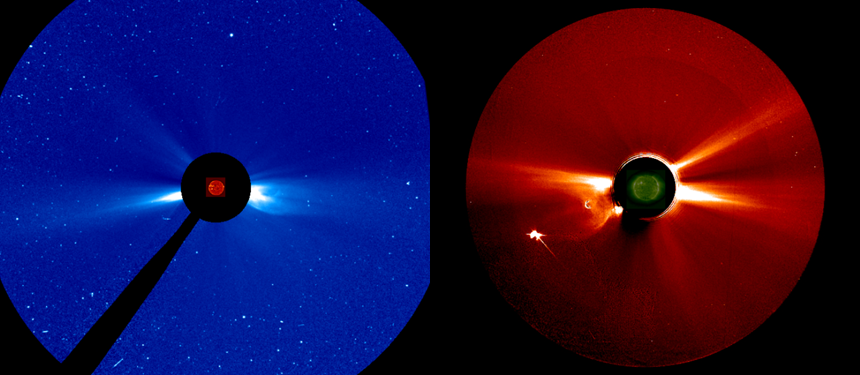
From the SDO/AIA 193 imagery, it is clear that little mass has been ejected into space, as very little coronal dimming (temporary darkening in the solar corona) can be seen. SOHO's wide angle coronagraph (LASCO/C3; https://sohowww.nascom.nasa.gov/ ) did not feature any appreciable coronal mass ejection (CME) in the expected direction, i.e. to the east (left). The STEREO-A coronagraph COR2 (https://stereo-ssc.nascom.nasa.gov/ ) does show a narrow CME right above a streamer to the west (right), but it is certainly not an obvious signature. Both images were taken around 18UT.
ESWW14 - a Design 4 a Ticket
Since 2006, each European Space Weather Week had a theme picture. For ESWW14, you will have the opportunity to design it.
It's worth the effort: the winning design is used for the website banner, the esww14 poster, presentations,... and wins a full week esww14 ticket!

Why this contest?
The esww13 conference dinner contest proved there was a lot of talent in the space weather community: http://www.stce.be/esww13/drawings/drawings.php
We will further explore these talents and creativity.
How you can participate?
Very simple: send your design before August 31 to the LOC . We need only a picture/image/cartoon/ ... no text. If your design wins, you should be able to hand it over with a minimum resolution of 150dpi and usable for be printed on an A4.
Who decides on the winning design?
A five member jury: Pepa Ivanova (Science Artist), David Jackson (PC member), Olivier Lemaitre (LOC), Mauro Messerotti(PC chair), Wim Vander Putten (Planetarium Brussels, designed the past esww themes) will take originality, creativity, practical integration, link with ESWW, clarity, ... into account.
When will the winner shall be announced?
As soon as the jury has reached a verdict, the winner shall be informed. An official announcement will appear on the front page of the ESWW14 website. This is foreseen by mid September.
Past designs
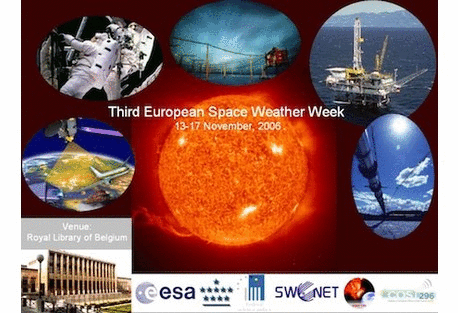
Check the website: http://www.stce.be/esww14/postercontest.php
PROBA2 Observations (12 Jun 2017 - 18 Jun 2017)
Solar Activity
Solar flare activity remained very low during the week.
In order to view the activity of this week in more detail, we suggest to go to the following website from which all the daily (normal and difference) movies can be accessed: http://proba2.oma.be/ssa
This page also lists the recorded flaring events.
A weekly overview movie can be found here (SWAP week 377):
http://proba2.oma.be/swap/data/mpg/movies/weekly_movies/weekly_movie_2017_06_12.mp4
Details about some of this week's events, can be found further below.
If any of the linked movies are unavailable they can be found in the P2SC movie repository here:
http://proba2.oma.be/swap/data/mpg/movies/
Tuesday Jun 13
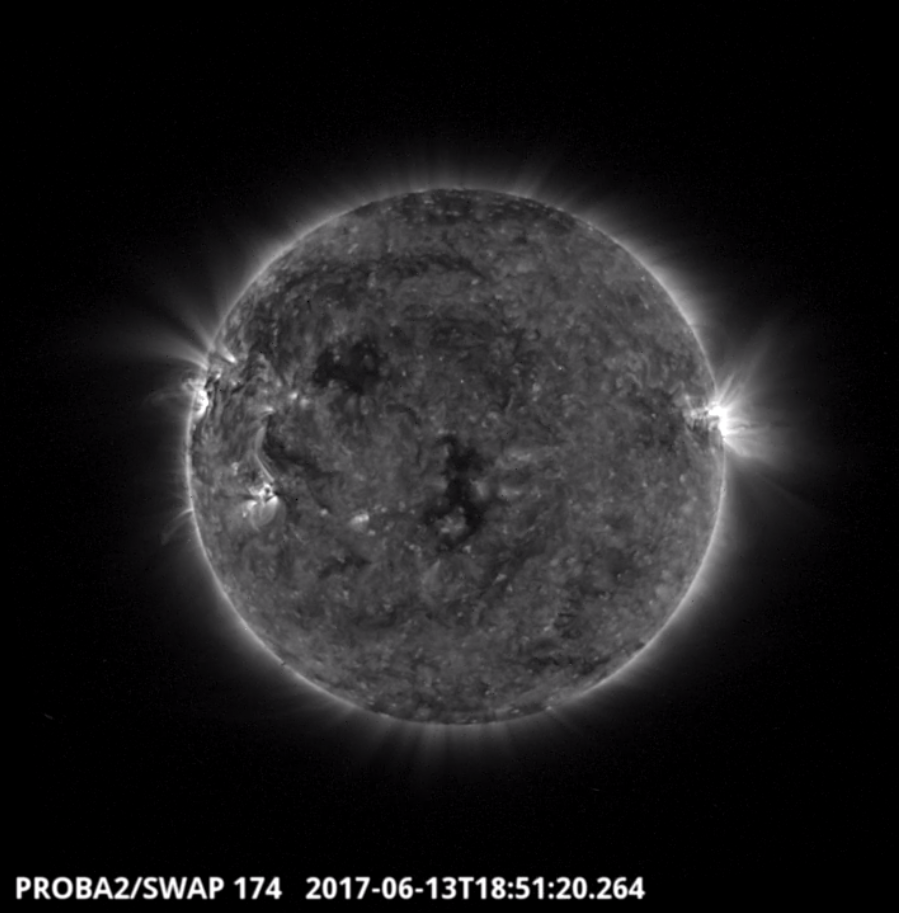
The largest flare of the week (B3.8) occurred on 2017-Jun-13 on the western limb, from NOAA active region 2661, and is shown in the SWAP image above at 18:51 UT.
Find a movie of the event here (SWAP movie):
http://proba2.oma.be/swap/data/mpg/movies/20170613_swap_movie.mp4
Review of solar activity
During this week solar flaring activity was very low with no C-class, and only 12 low B-class flares reported. This can be seen in the GOES X-ray graph below.
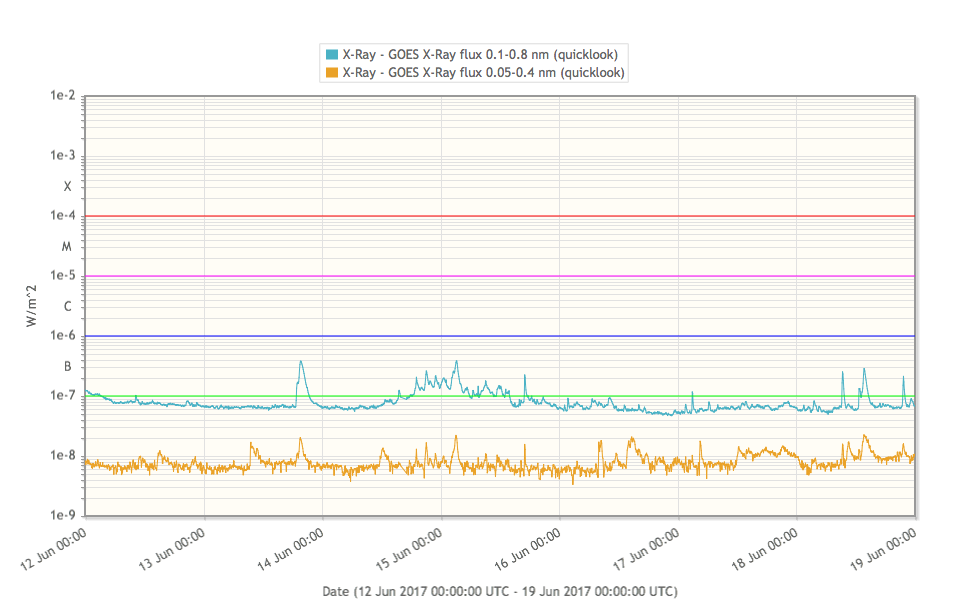
Accordingly there was no wide CMEs observed this week.
Three coronal holes were observed this week. First one was the equatorial coronal hole which reached the central meridian in the morning of June 13. Two other coronal holes, one on the north and one on the south solar hemisphere, reached central meridian almost simultaneously, in the evening of June 14.
The coronal holes are drawn on the SDO/AIA 171 images below. The data about the coronal holes come from the SWEK database.
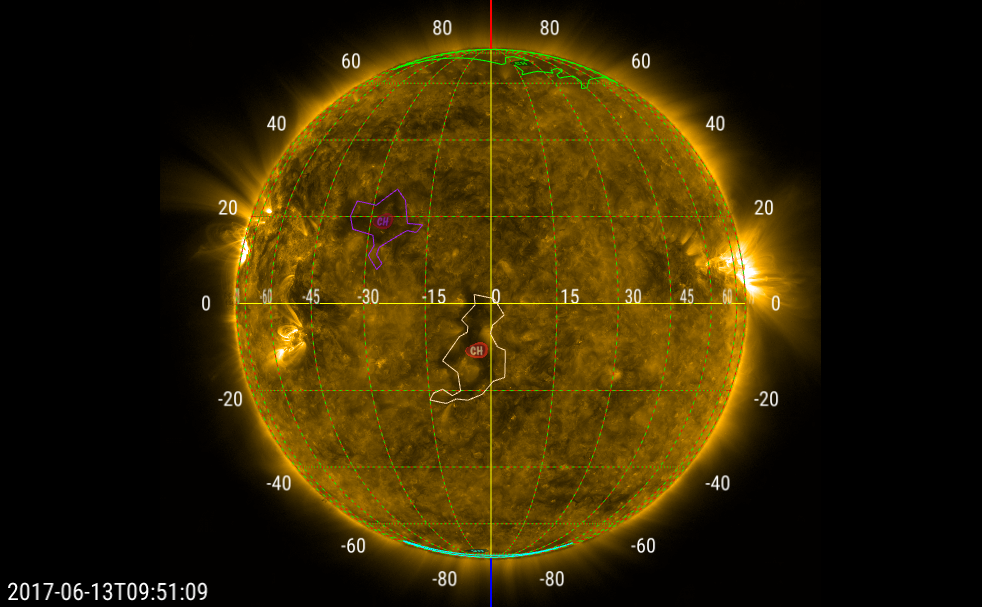
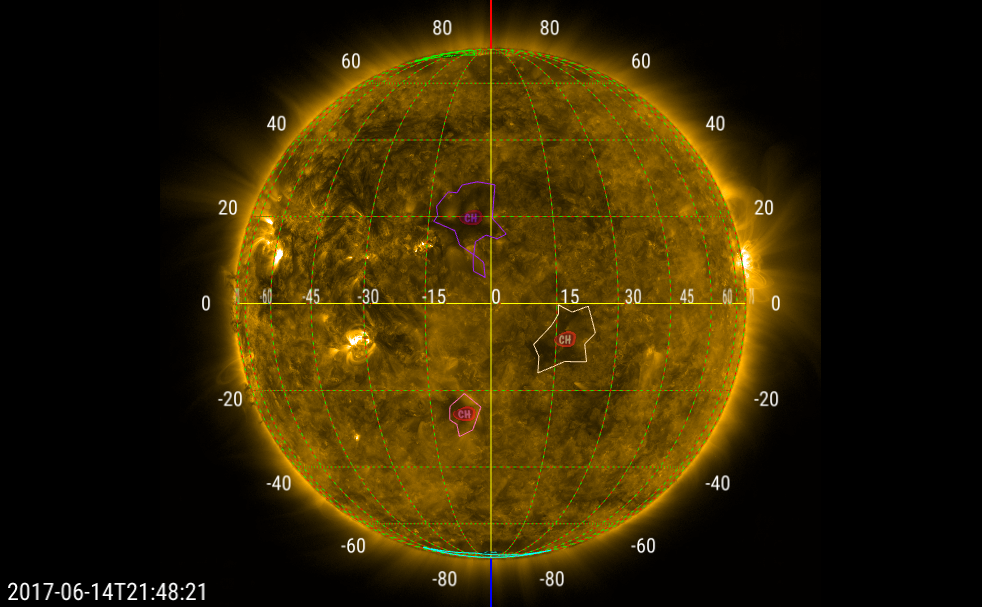
The International Sunspot Number
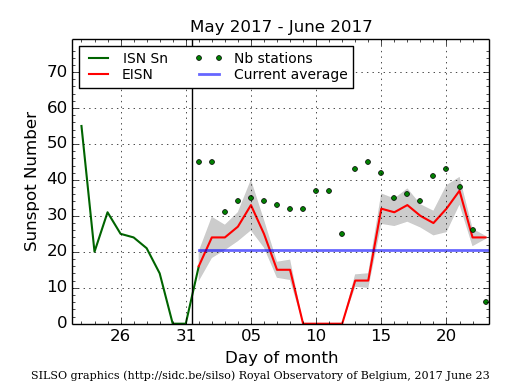
The daily Estimated International Sunspot Number (EISN, red curve with shaded error) derived by a simplified method from real-time data from the worldwide SILSO network. It extends the official Sunspot Number from the full processing of the preceding month (green line). The plot shows the last 30 days (about one solar rotation). The horizontal blue line shows the current monthly average, while the green dots give the number of stations included in the calculation of the EISN for each day.
Review of geomagnetic activity
During the first two days of the week (June 12 and 13) somewhat enhanced solar wind speed was observed, associated with the small equatorial coronal hole which reached central meridian on June 08.
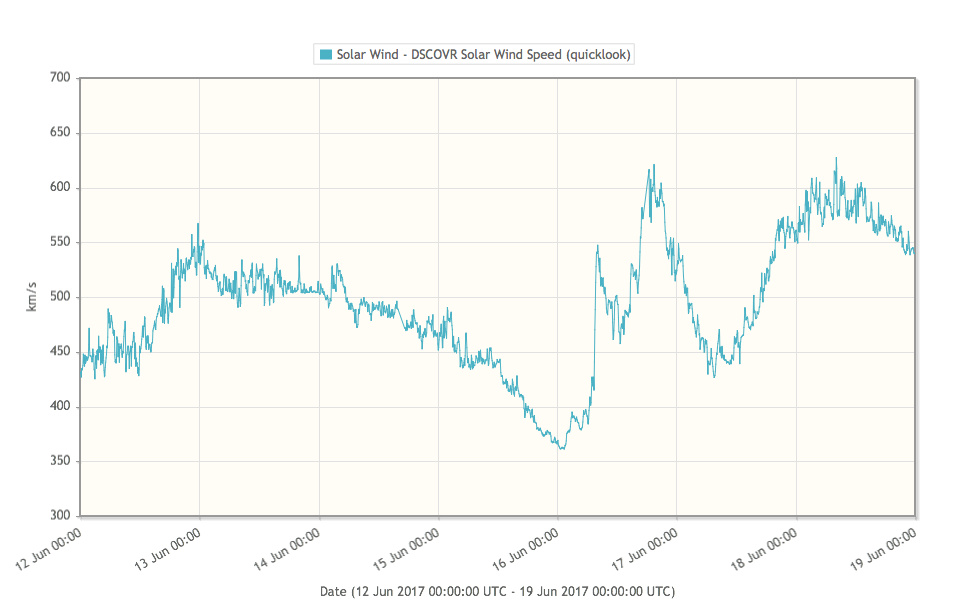
The in situ observations indicated arrival of the fast solar wind (associated with the large equatorial coronal hole which has reached the
central meridian in the morning of June 13), in the morning of June 16. At about 03:00 UT, sudden increase of the interplanetary magnetic field (IMF) and the density increase was observed, soon followed with the change of the phi angle. The strong oscillations of the IMF and its Bz component were followed by sudden increase of the solar wind speed, density and temperature marking the interaction region between the slow and fast solar wind. The maximum of the solar wind speed of about 600 km/s was reached in the evening of June 16.
Starting from about midday of June 17, the solar wind speed began to increase simultaneously with the temperature, and with the density decrease indicating arrival of the fast solar wind associated with two large coronal holes (one on the north and one on the south solar hemisphere) which reached central meridian in the evening of June 14. Although it was difficult to distinguish which of the two coronal holes is associated with this increase of the solar wind speed, it seems more probably that this was the coronal hole on the north solar hemisphere. At the end of the week Earth was still within the fast solar wind with the speed of about 540 km/s.
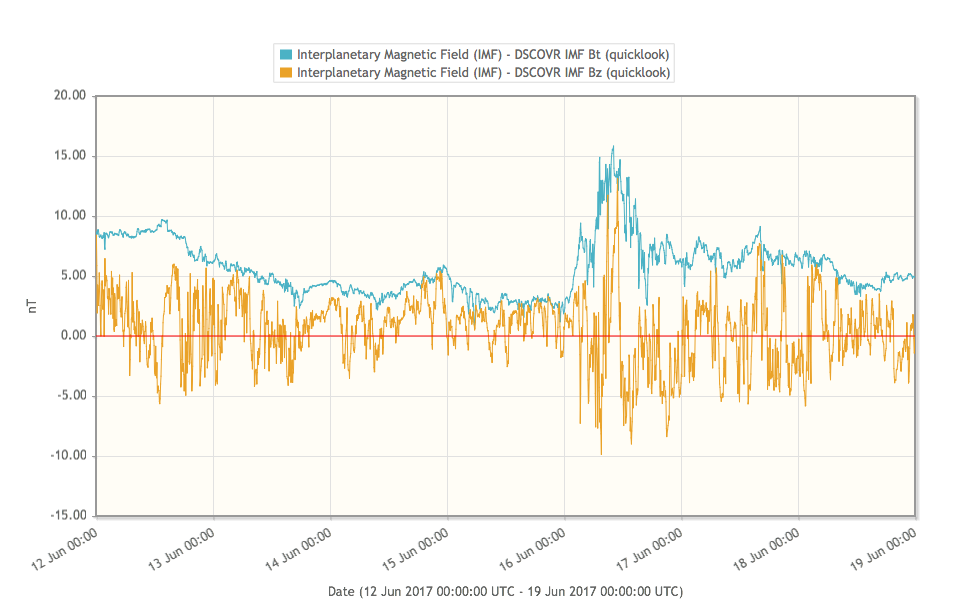
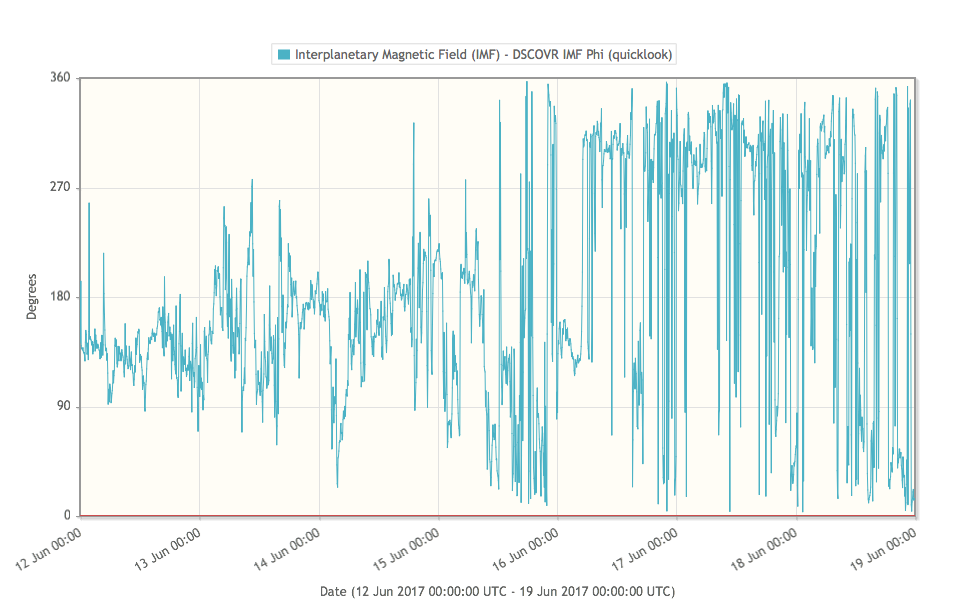
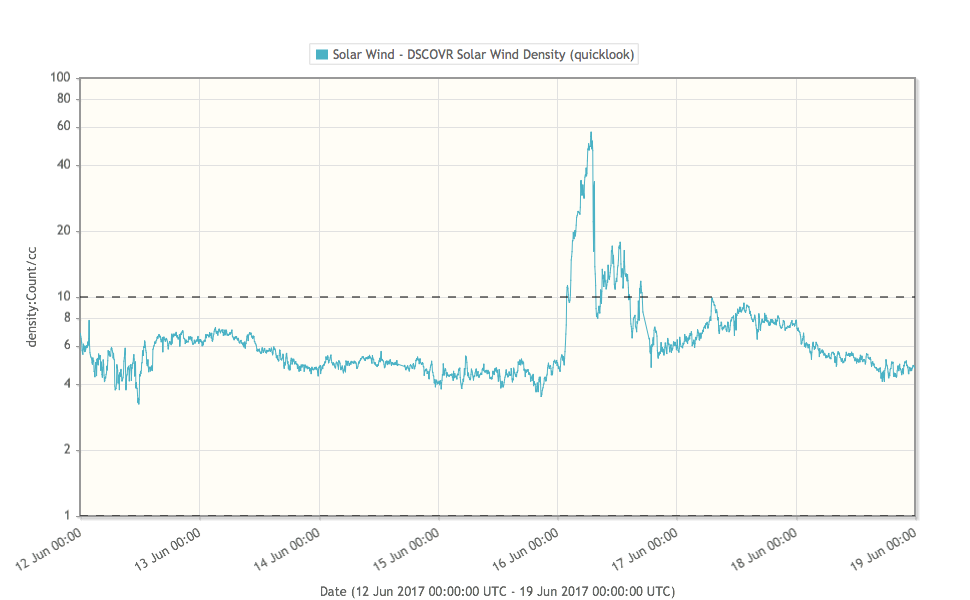
During this week geomagnetic conditions were mostly quiet to unsettled, except the interval of active to minor storm conditions reported on June 16 and early morning of June 17 (associated with the fast solar wind)
SIDC Space Weather Briefing
These are the slides presented during the Monday June 18 Space Weather Briefing given by the forecaster that was on duty from June 12 to June 18. It reflects in images and graphs what is written down in the Solar and Geomagnetic Activity report in this news letter.

Review of ionospheric activity (12 Jun 2017 - 18 Jun 2017)
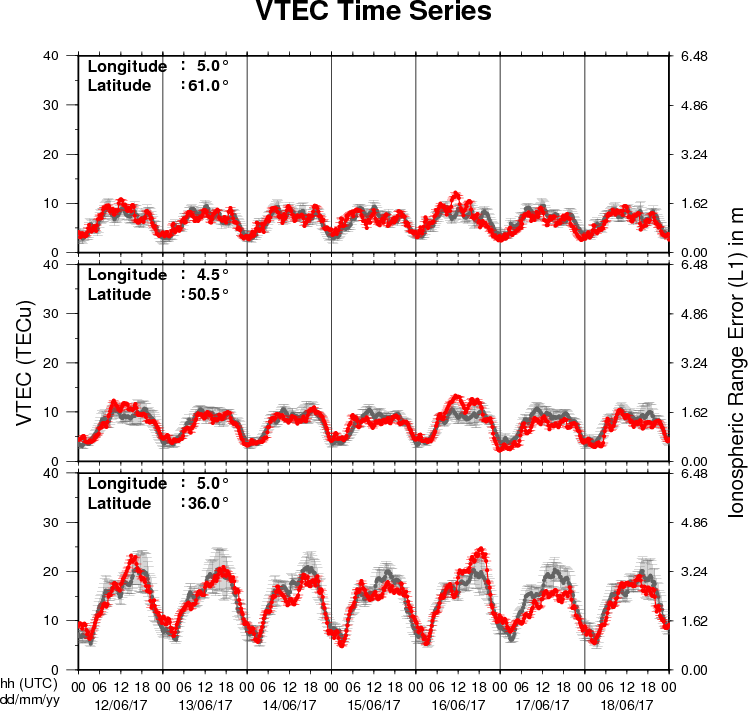
The figure shows the time evolution of the Vertical Total Electron Content (VTEC) (in red) during the last week at three locations:
a) in the northern part of Europe(N61°, 5°E)
b) above Brussels(N50.5°, 4.5°E)
c) in the southern part of Europe(N36°, 5°E)
This figure also shows (in grey) the normal ionospheric behaviour expected based on the median VTEC from the 15 previous days.
The VTEC is expressed in TECu (with TECu=10^16 electrons per square meter) and is directly related to the signal propagation delay due to the ionosphere (in figure: delay on GPS L1 frequency).
The Sun's radiation ionizes the Earth's upper atmosphere, the ionosphere, located from about 60km to 1000km above the Earth's surface.The ionization process in the ionosphere produces ions and free electrons. These electrons perturb the propagation of the GNSS (Global Navigation Satellite System) signals by inducing a so-called ionospheric delay.
See http://stce.be/newsletter/GNSS_final.pdf for some more explanations ; for detailed information, see http://gnss.be/ionosphere_tutorial.php
Future Events
For more details, see http://www.spaceweather.eu/en/event/future
United Nations/United States of America Workshop on the International Space Weather Initiative in Massachusetts (USA)
Start : 2017-07-31 - End : 2017-08-04
This workshop marks the 10th anniversary of the International
Heliophysical Year, which led to the genesis of the International
Space Weather Initiative. It is organized jointly by the Office for
Outer Space Affairs, the National Aeronautics and Space
Administration (NASA) and Boston College to highlight the
achievements made over the past ten years and to show-case the
worldwide development of science, capacity building, and
outreach.
The UN Workshops on ISWI have been aimed at providing a global
forum for space weather experts from developed and developing
countries, including representatives of the major instrument
operators and data providers. In particular the Workshop will focus
on recent advances made in scientific research by utilizing ISWI
instrument data in conjunction with space mission data in adding
significant new knowledge on space weather phenomena near Earth and
interplanetary space.
The workshop will begin with a high level international forum on
the economic and societal effects of extreme space weather. This
forum will include keynote speakers from major international
organizations followed by a panel session to discuss issues and
policies for acknowledging space weather as a global challenge.
The workshop is also held in preparation for UNISPACE+50 in
2018, the 50th anniversary of the first UN Conference on the
Exploration and Peaceful Uses of Outer Space (UNISPACE), held in
Vienna in 1968. The three components of the Workshop will also help
develop a coherent international policy towards an appropriate
response to space weather.
Website: https://iswi2017.bc.edu/
URSI General Assembly in Montreal, Canada
Start : 2017-08-19 - End : 2017-08-26
For the thirty-second time since the inception of URSI, Radio
Scientists from across the world will get together for the URSI
General Assembly and Scientific Symposium. This triennial gathering
will take place from 19th to 26th of August 2017, in Montreal,
Canada. This conference is a unique opportunity to learn about
recent advances in all fields of Radio Science, as covered by all
ten URSI Commissions.
Among the different sessions, please note:
* 'Radio Science for Space Weather'
Conveners: M. Messerotti, V. Pierrard
* 'Remote Sensing and Modeling of the Earth's Plasmasphere
and Plasmapause'
Conveners: A. M. Jorgensen, V. Pierrard, B. Heilig
The abstract deadline is 30 January 2017
Website: http://www.ursi2017.org
2017 Joint IAPSO-IAMAS-IAGA Assembly in Cape Town, South Africa
Start : 2017-08-27 - End : 2017-09-01
The Joint IAPSO-IAMAS-IAGA Assembly, endorsed by the University
of Cape Town and the South African Department of Science and
Technology, will take place from 27 August to 1 September 2017 at
the Cape Town International Convention Centre (CTICC). Several IAGA
and IAMAS sessions are of Space Weather interests as well as the
joint session 'Space Weather throughout the Solar System: Bringing
Data and Models together'.
Website:
http://iapso-iamas-iaga2017.com/index.php
Workshops on Radiation Monitoring for the International Space Station in Torino, Italy
Start : 2017-09-05 - End : 2017-09-07
The Workshop on Radiation Monitoring for the International Space
Station is an annual meeting to discuss the scientific definition
of an adequate radiation monitoring package and its use by the
scientific community on the ISS. Types of instruments and research
topics need to be defined in order to optimise the radiation safety
of the ISS crew.
Website: http://wrmiss.org/
International Workshop on Solar, Heliospheric & Magnetospheric Radioastronomy in Meudon, France
Start : 2017-11-06 - End : 2017-11-10
Jean-Louis Steinbeg has been one of the major pioneers in
radioastronomy. Co-founder of the Nançay Observatory, he
has actively participated to, an inspired a large number of radio
instruments on many international space missions. Jean-Louis
Steinberg is the founder of the Space Radioastronomy laboratory of
the Paris Observatory in 1963. Later on, this laboratory widened
its science interests and became the DESPA (1971) and then the
current LESIA (2002) which is one of the major space sciences
laboratories in France. The aim of this workshop is to cover the
science topics which Jean-Louis Steinberg has promoted during his
career, focusing on Solar, Heliospheric & Magnetospheric
radioastronomy & physics. This will be done by covering both
observations from either ground facilities (NDA, RH, LOFAR, Artemis
etc ...) or space missions (ISSEE, Ulysses, WIND, CLUSTER, STEREO,
CASSINI, JUNO etc ...) and models/theories. A series of invited
talks is also foreseen to cover the new developments in the
discipline which may come with the future facilities such as Solar
Orbiter, Solar Probe Plus, JUICE, JUNO, LOFAR+, SKA etc ....
This workshop will also be the opportunity to remember both the
extraordinary personal & professional lifes of Jean-Louis
Steinberg especially for new generation of scientists. At the
occasion of this workshop it is also expected that the Building 16
(historical Space Sciences building) on the Meudon campus will be
renamed "Building Jean-Louis Steinberg".
Website:
https://jlsworkshop.sciencesconf.org/
European Space Weather Week 14
Start : 2017-11-27 - End : 2017-12-01
The ESWW is the main annual event in the European Space Weather
calendar. It is the European forum for Space Weather as proven by
the high attendance to the past editions. The agenda will be
composed of plenary/parallel sessions, working meetings and
dedicated events for service end-users. The ESWW will again adopt
the central aim of bringing together the diverse groups in Europe
working on different aspects of Space Weather.
Website:
http://www.stce.be/esww14/
